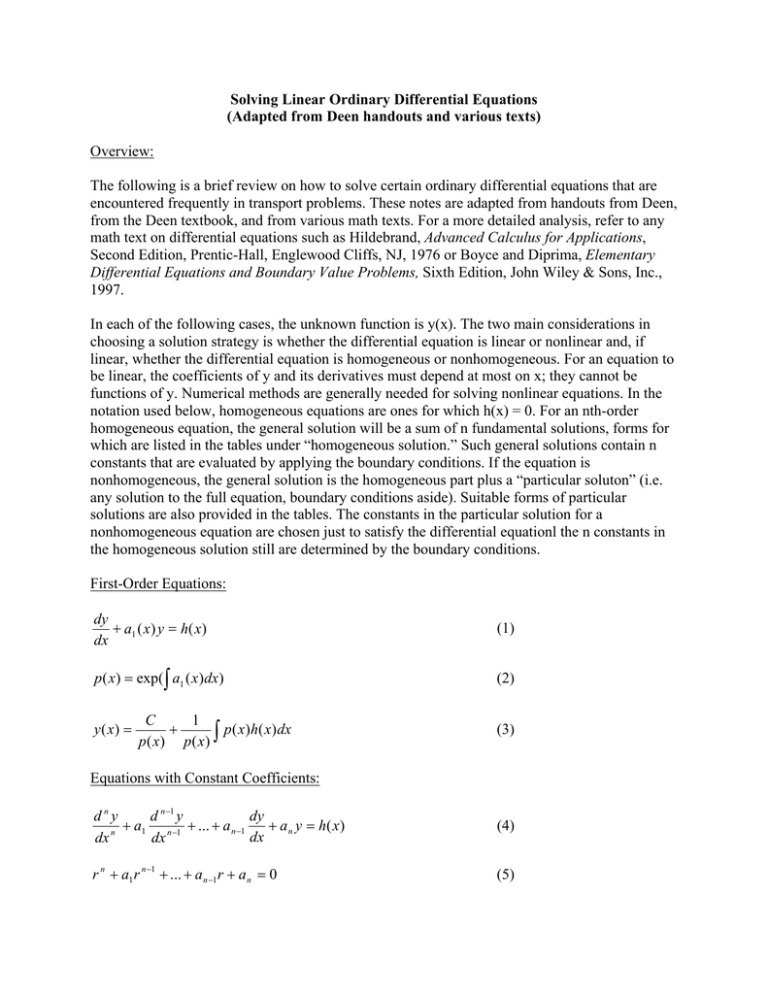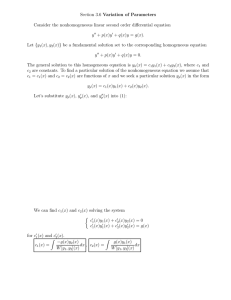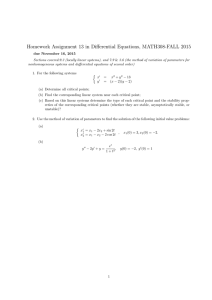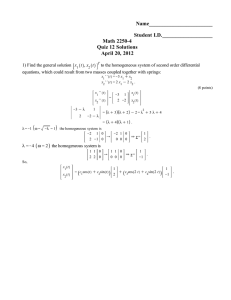Solving Linear Ordinary Differential Equations Overview:
advertisement

Solving Linear Ordinary Differential Equations (Adapted from Deen handouts and various texts) Overview: The following is a brief review on how to solve certain ordinary differential equations that are encountered frequently in transport problems. These notes are adapted from handouts from Deen, from the Deen textbook, and from various math texts. For a more detailed analysis, refer to any math text on differential equations such as Hildebrand, Advanced Calculus for Applications, Second Edition, Prentic-Hall, Englewood Cliffs, NJ, 1976 or Boyce and Diprima, Elementary Differential Equations and Boundary Value Problems, Sixth Edition, John Wiley & Sons, Inc., 1997. In each of the following cases, the unknown function is y(x). The two main considerations in choosing a solution strategy is whether the differential equation is linear or nonlinear and, if linear, whether the differential equation is homogeneous or nonhomogeneous. For an equation to be linear, the coefficients of y and its derivatives must depend at most on x; they cannot be functions of y. Numerical methods are generally needed for solving nonlinear equations. In the notation used below, homogeneous equations are ones for which h(x) = 0. For an nth-order homogeneous equation, the general solution will be a sum of n fundamental solutions, forms for which are listed in the tables under “homogeneous solution.” Such general solutions contain n constants that are evaluated by applying the boundary conditions. If the equation is nonhomogeneous, the general solution is the homogeneous part plus a “particular soluton” (i.e. any solution to the full equation, boundary conditions aside). Suitable forms of particular solutions are also provided in the tables. The constants in the particular solution for a nonhomogeneous equation are chosen just to satisfy the differential equationl the n constants in the homogeneous solution still are determined by the boundary conditions. First-Order Equations: dy + a1 ( x) y = h( x) dx (1) p( x) = exp( ∫ a1 ( x)dx) (2) y ( x) = 1 C + p( x)h( x)dx p( x) p( x) ∫ (3) Equations with Constant Coefficients: dny d n −1 y dy a + + ... + a n −1 + a n y = h( x ) 1 n n −1 dx dx dx (4) r n + a1 r n −1 + ... + a n −1 r + a n = 0 (5) Root of a Characteristic Equation Homogeneous Solution r a single root (real) e rx (6) r1 a double root (real) e r1 x (C 0 + C1 x) (7) r1 an m-fold root (real) e r1 x (C 0 + C1 x + ... + C m −1 x m −1 ) (8) r = a ± bi (complex conjugates) e ax (C1 cos bx + C 2 sin bx) (9) Nonhomogeneous Term, h(x) Particular Solution Cx m A0 + A1 x + ... + Am x m Cx m e ax (A + A1 x + ... + Am x m e ax (A + A1 x + ... + Am x m e ax cos bx + B0 + B1 x + ... + Bm x m e ax sin bx Cx m e ax cos bx or Cx m e ax sin bx 0 0 (10) ) ) (11) ( ) (12) Notes: 1. If any term in the trial form of the particular solution appears in the homogeneous solution, multiply the entire expression for the particular solution by x k . Here k is chosen as the smallest positive integer that will prevent the duplication. 2. If h(x) consists of a sum of terms, add the particular solutions corresponding to each. Equidimensional Equations: xn n −1 dny y dy n −1 d b x + + ... + bn −1 x + bn y = h( x) 1 n n −1 dx dx dx [r (r − 1)...(r − n + 1)] + b1 [r (r − 1)...(r − n + 2)] + ... + bn−1r + bn = 0 (13) (14) Equidimenional Equations (cont.): Root of Characteristic Equation Homogeneous Solution r a single root (real) xr (15) r1 a double root (real) x r1 [C 0 + C1 ln x ] (16) r1 an m-fold room (real) x r1 C 0 + C1 ln x + ... + C m −1 (ln x) m −1 r = a ± bi (complex conjugates) x a [C1 cos(b ln x) + C 2 sin(b ln x)] [ Nonhomogeneous Term, h(x) ] (17) (18) Particular solution x s (s ≠ r ) Ax s (19) x s (s = r ) Ax s (ln x) k (20) Notes: 3. In eq. (20), k is chosen as the smallest positive integer that will prevent the particular solution from duplicating part of the homogeneous solution. 4. If h(x) consists of a sum of terms, add the particular solutions corresponding to each. Special Cases: Bessel’s equation x ( ) d dy 2 2 2 x + m x −v y = 0 dx dx (21) Solution y = A1 ⋅ J v (mx) + A2 ⋅ Yv (mx) , (22) where J v , Yv are Bessel functions of order v of the first and second kind, respectively. See Deen, p. 168 for more properties of Bessel functions. Modified Bessel Functions x ( ) d dy 2 2 2 x − m x +v y = 0 dx dx (23) Solution y = A1 ⋅ I v (mx) + A2 ⋅ K v (mx) , (24) where I v , K v are modified Bessel functions of order v of the first and second kind, respectively. See Deen, p. 172 for more properties of Modified Bessel functions. Legendre Equation and Polynomials (1 − x ) ddx y − 2 x dy + α (α + 1) y = 0 dx 2 2 2 , where α is a constant (25) Legendre Polynomials. Pn (x) is the polynomial solution of Legendre equation with α = n that also satisfies the condition Pn (1) = 1 . See Gustafson handout from lecture 3 for more information. Rodrigues’ formula: Pn ( x) = ( ) n 1 dn 2 x − 1 for all positive n. n n 2 n! dx (26)


